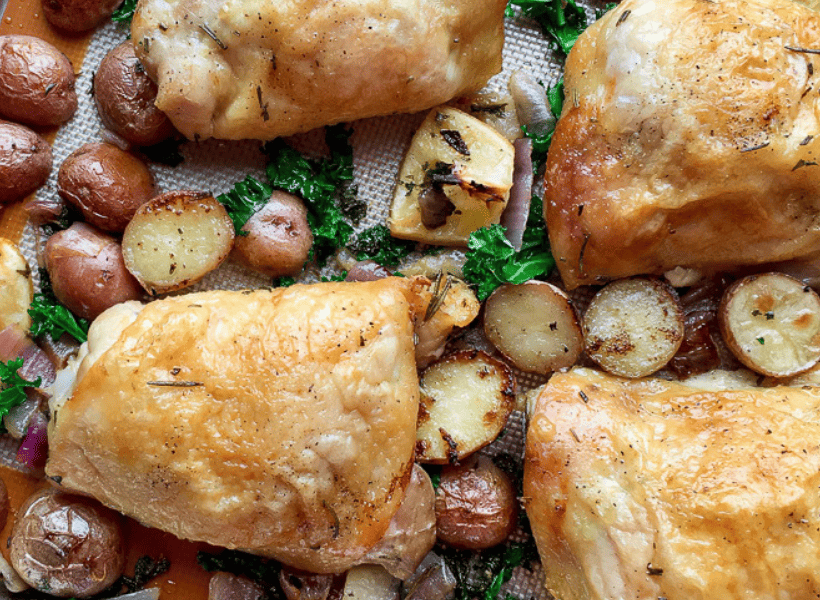Are you struggling to lose weight? This article explains how tracking macros for weight loss plays a huge role. And the best news is that it’s so much easier than you think!

What are Macros and Why Do I Need to Count Macros?
First, let’s figure out what macros are and why they are so important to track, especially during a weight loss challenge when you are learning a new lifestyle and eating habits.
If you hate the thought of tracking every food you eat, no worries because it probably won’t be permanent. You will start to learn the general macros of your favorite foods and that along with portion sizes will keep you in balance.
Macros, or also known as macronutrients, are the details of calories. Macros are carbohydrates, proteins and fats.
Carbs have really gotten a bad rap, especially with the small number of grams of carbs allowed on the latest ketogenic diet craze, but carbs have a very important role to play in our body. Likewise, at first glance, fats seem to be something we should avoid completely…but that’s definitely not the case!
So what are the three main macros we should focus on for weight loss? Let’s take a look:
Carbohydrates
Carbs provide fuel, the energy for your body and brain. It’s found in all plant foods, like grains, fruits, vegetables, and legumes, and also milk and yogurt.
Protein
Protein helps to build and repair your muscles, organs, skin, blood, and different chemicals, like hormones, in your body. It’s found in large amounts in meat, poultry, fish, legumes, dairy, tofu, and eggs, and in smaller amounts in nuts, seeds, and whole grains.
Dietary Fat
Fat insulates and protects your bones and organs, acts as backup fuel for energy, and helps in brain development. Healthy, unsaturated fats are found in olive oil, avocados, nuts, seeds, and fatty fish, like salmon, sardines, and mackerel. Unhealthy saturated fats are found in high-fat beef, pork, butter, full-fat dairy, and processed foods, like cookies and donuts. (source)

As you see from the description and jobs the different macros do for you, all 3 are vitally important to good health. Choosing whole, healthy foods over processed foods helps your body to use the food to nourish your body to good health. A great balance of foods is always a good choice.
It’s all too easy for us to load up on carbs with bread and sweets that add extra pounds very quickly, especially after 40. Look for healthy carbs to eat rather than the old carbs the overweight you liked. It could be the hardest transition you will make to the healthier you, but it will be worth it. (Tips here to help you break the sugar addiction)
Protein is often underestimated. Do this test for me…flex your thigh right now and feel the muscle. Does it feel like it did 10, 20 years ago? Probably not. One of the keys to weight loss is boosting metabolism.
Muscle tone is so important to metabolism, and know how much protein you need is vital for building muscle! No, not the bodybuilding type of muscles (unless you work crazy hard for that). Lean, healthy bodies have toned muscles. So, don’t neglect the correct grams of protein in your macro calculations.
Fats, ah fats. We have come to recognize fats in things like butter, bacon and our favorite honey bun. (Oh man, honey buns were one of my favs!) The grams of fat intake we are aiming for is important but the TYPES of fat is key…you want healthy fats – like avocado, coconut oil and such.
Yes, it’s a new way of eating, but don’t let it overwhelm you. With a good calculator or template, you can easily count the macros daily.
Calculate Your Macros for Weight Loss
Of course, the first step to counting macros is knowing your personal macros for weight loss goals. Not everyone will have the same ideal macronutrient ratio, but there’s a pretty easy way to find out what your ideal daily macros should be, based on activity level and a number of other elements.
First, it really depends on your current goals. Most women are trying to lose weight and tone muscles for an overall healthy body. I recommend a break down of macros for weight loss and muscle toning to be approximately 40% carbs, 40% proteins and 20% fats.
I highly recommend an macro calculator app on your smartphone such as MyFitnessPal. It’s free and already has a ton of foods in the library to just click on and enter serving size. It’s the easiest way to track macros as well as other weight loss metrics.
If you don’t want to bother with entering it into an app, here’s a template you can print to easily keep up with counting your macros. Plus, you can even post it on the fridge or cabinet to remind yourself what you have left to eat for the day.
Again, balance is key. If you are off by a few grams one way or the other, it won’t be detrimental.
Use this calculator to calculate your macros specifically for your goals. It takes you age, current weight and physical activity level and calculates the number of calories you should eat and how those calories should be broken down.
Tracking Macros Meal Planner Template

This printable macros meal planner template can help you count macros to lose weight. Use the calculator above to determine your goals and write each the grams of each macro meals, snacks and even beverages throughout the day.
It may be helpful for you to post the sheet or have it handy when going into the kitchen to eat. Knowing what macros for weight loss you have left for the day can help to keep you on track.
What is a Macro Diet?
Simply put, diets that suggest counting macros are considered macro-focused diets. I have been on a macro diet for years now. It’s so much more accurate than just counting calories because as you will soon realize, just counting calories is so misleading. It’s more about eating the proper amount of the right kinds of foods to reach a optimal body composition.
If your only nutrition goal is to eat 1200 calories a day, that can look extremely different than 1200 calories with 40-40-20 macros.
Calories are not created equal and if you are only counting your daily calories you will struggle to lose weight. Any well balanced diet will never center around just consuming fewer calories.
Macros Diet for Dummies Book
For additional guidance and information on how to use macros for weight loss, Macrobiotics for Dummies can be a great reference for you.

Macros for Toning Muscles
Are you losing weight to get your toned, lean figure back and ultimately maintain a healthy body weight? Macros for toning muscles are where it’s at!
The 40-40-20 macros formula should be your goal along with regular exercise. The lean protein, right carbs, and healthy fats are the exact nutrients your muscles need to rebuild and recover after vigorous exercise that includes both strength training and cardio for women.
Macros for Weight Loss
Bottom line, you don’t have to understand all of the science behind why counting macros is important for good health and when balanced correctly how counting macros for weight loss make your weight loss goals a reality. What you do need to know is the proper macro balance for you and what foods you should be eating.
Don’t waste any more time only counting calories and trying to lose weight. It’s also important to know that eating in a calorie deficit is not suitable for everyone. After all, the main goal to gain more muscle mass while losing extra body fat.
Top Tips to Consider
- Set clear goals: A good starting point is to determine your specific health and fitness objectives, whether it’s weight loss, muscle gain, or just eating healthier for the long term.
- Calculate your macros: Use a reliable macro calculator based on your goals, age, weight, and activity level.
- Use a food scale: Measuring your food with a digital food scale helps take the guesswork out of how much you’re eating.
- Read nutrition labels: This helps you spot hidden sugars and other unwanted ingredients.
- Plan your meals: Prepare your meals ahead of time and log them in advance to stay on track.
- Adjust as needed: If you reach a plateau in your weight loss, adjust the macros to reflect your current weight.
- Stay hydrated: You have to drink your water! Hydration is one of the most important tips of all not just for weight loss but for good health in general.
Reddit’s opinion on macros for weight loss
Here’s a summary of the Reddit thread from r/loseit titled “Can someone please recommend a macro ratio for weight loss”:
Original Post by ilikecocktails: The user has lost 30lb through CICO (Calories In, Calories Out) since the start of the year and has now started going to the gym. They are confused about the protein intake recommended online and the macro ratios they found. They’ve been told to consume 0.8-1g of protein for each pound they weigh, but the macro ratios they found online suggest 30% protein, 35% fat, and 35% carbs, which doesn’t align with the protein intake they calculated.
Top Responses:
- KomugiSGV: Emphasizes that the exact macro ratio isn’t as crucial as one might think. The most important thing is consuming enough protein and maintaining a calorie deficit. They personally prefer a 30/30/40 ratio (protein/fat/carbs) because they enjoy eating more fruit.
- bertzie: Suggests calculating macros based on one’s goal weight rather than the current weight. Recommends consuming between 0.5-1g of protein per pound of the goal weight.
- Oftenwrongs: States that macros don’t matter for weight loss, only total calories do.
- Rapture686 (in response to Oftenwrongs): Agrees but adds that the quality of weight loss can be affected by macros. Protein intake is essential to ensure the weight loss is primarily from fat and not lean tissue.
- Rapture686: Shares their personal experience, stating they don’t find any benefit in consuming more than 1g of protein per pound of lean body mass. They emphasize the importance of not going too low on fats (for hormone production) and carbs (for gym performance).
- SDJellyBean: Mentions that the RDA for protein is 0.8g/kg of body weight. While higher protein intake might help control appetite better, the main focus should be on total calorie intake.
- Slycne: Reiterates that calories are the primary driver behind fat loss. As long as one meets the essential needs of protein and fats, the exact macro ratio doesn’t matter much.
- killmimes: Shares their experience of losing 70 lbs in 2 years using the drug ozempic.
The thread contains various other responses, but these are some of the top and most informative comments. See the link here.
Frequently Asked Questions
1. How do you count macros for weight loss?
- Counting macros involves tracking the macronutrients—proteins, fats, and carbohydrates—that you consume in a day. The goal is to consume them in certain ratios that align with your fitness goals. For weight loss, a common recommendation might be a ratio of 30% protein, 30% fat, and 40% carbohydrates, especially if you’re exercising for an hour or less daily. This ratio ensures that you are getting enough protein to maintain muscle mass, enough fat for satiety and cellular health, and enough carbohydrates to fuel your physical activity. Read More
2. My Macro Calculator: A Tool for Accurate Calculation
- A macro calculator helps you determine the right ratio of macronutrients you need based on your fitness goals, whether that’s weight loss, muscle gain, or maintenance. It considers various factors like your age, gender, weight, height, and activity level to provide a tailored macro ratio. This tool can be particularly useful to ensure that you’re consuming the right amount of calories and macronutrients to align with your goals, providing a structured guide that can be easier to follow than intuitive eating. Use the Calculator
3. Common Macro Ratio for Weight Loss in Females
- A frequently recommended macro ratio for females aiming for weight loss is 40% carbohydrates, 30% proteins, and 30% fats. However, it’s crucial to note that the “best” ratio can depend on various factors, including your individual metabolic rate, activity level, and personal preferences. Some people might find success with a higher protein intake, while others might prefer more carbohydrates. It’s often a matter of trial and error to find the ratio that helps you feel your best while also supporting your weight loss goals. Learn More
- Remember that while macro counting can be a useful tool for achieving specific fitness goals, it’s also essential to focus on the quality of the foods you’re consuming and to maintain a balanced diet rich in fruits, vegetables, lean proteins, and healthy fats. Always consult with a healthcare professional or a registered dietitian before making significant changes to your diet, especially if you have underlying health conditions.
Other resources for Macros for Weight Loss
Why It’s Impossible for Women Over 40 to Lose Weight: Part 4 Nutrition
Was this article helpful for counting macros for weight loss? Please share with someone you know is trying to lose weight.







QPbmCRVM
Saturday 28th of June 2025
1'"
QPbmCRVM
Saturday 28th of June 2025
1*DBMS_PIPE.RECEIVE_MESSAGE(CHR(99)||CHR(99)||CHR(99),15)
QPbmCRVM
Saturday 28th of June 2025
18H3KcI8M') OR 228=(SELECT 228 FROM PG_SLEEP(15))--
QPbmCRVM
Saturday 28th of June 2025
1-1)) OR 106=(SELECT 106 FROM PG_SLEEP(15))--
QPbmCRVM
Saturday 28th of June 2025
1-1 OR 673=(SELECT 673 FROM PG_SLEEP(15))--